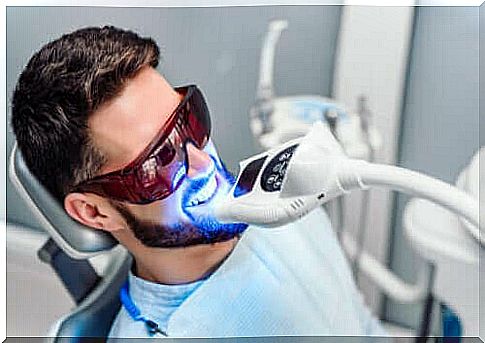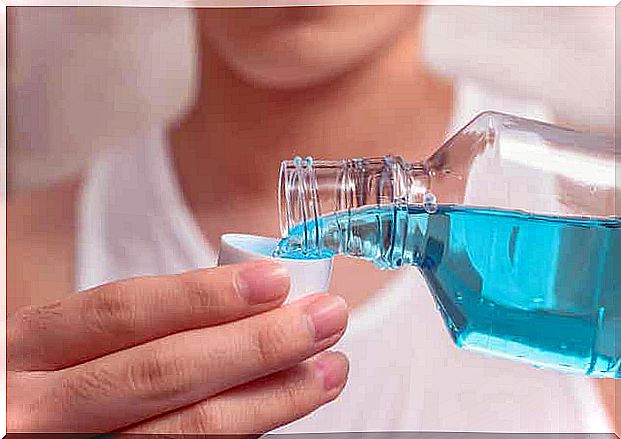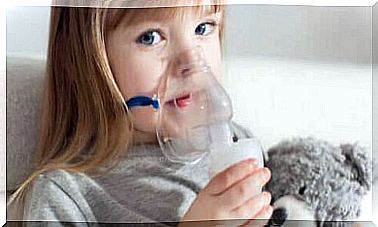How Long Does Teeth Whitening Last?

Who has never looked at teeth whitening? Having a beautiful and radiant smile is an increasingly common concern for many people. How long does the effect of teeth whitening actually last?
Having beautiful teeth is an easily accessible option with the treatments available today. There are more and more possibilities to improve the appearance of our mouth.
Teeth whitening is a procedure that uses chemicals that can remove pigments and stains from tooth surfaces. The treatments in dental offices are a good option, but there are also products that you can use at home.
The results and duration of effect of these products vary. In this article, we’ll tell you about the most commonly used methods and how long the teeth whitening effect lasts. We also give you some tips to make the effects last longer.
Types of teeth whitening and their duration
We have already mentioned that teeth whitening removes stains from tooth surfaces and thus gives the smile a more attractive appearance. The types of stains, the products and methods used, and the patient’s habits determine the duration of the result.
While the effects of teeth whitening are long-lasting, they are not permanent. Below we describe some of the most commonly used treatments (Spanish link) and how long the effects usually last.
Home options
This includes the products that someone can buy at the pharmacy or drugstore and apply themselves. These are whitening gels or pastes that generally have a limited effect. It does not include professional teeth whitening treatments that someone does at home, but goes under the supervision and follow-up of the dentist.
Natural methods or homemade recipes with everyday products are also not described, as it is not advisable to use them. They are not effective and can pose a risk of damage to tooth structures.
Whitening toothpaste
This is a toothpaste for daily use, but with added ingredients that provide a whitening effect. They usually contain abrasives, hydrogen peroxide and carbamide peroxide.
The types that contain only abrasives work on superficial stains, without changing the color of the teeth. The products containing peroxides can whiten teeth and remove stains.
Manufacturers recommend daily use, twice a day, for several weeks. However, results may only be visible after 2 to 6 weeks of use and last for 3 to 4 months.
The effects can be prolonged by continuing to use the whitening paste, but this is not recommended. The ingredients they contain are not designed for frequent use and cause irreversible damage to the enamel. They can also irritate soft tissues, such as gums, and cause sensitive teeth.
In cases where one chooses to use these pastes regularly and for a long time, it is necessary to combine the use with pastes that protect and strengthen the enamel to prevent damage.
Mouthwash with whitening effect

Mouthwashes with whitening effect are used to maintain the effect of other treatments performed in the dental office. This type of teeth whiteners are mouthwashes that contain hydrogen peroxide. The recommendation is to perform a daily rinse to remove surface stains.
The results usually appear after 3 months of use and are not as noticeable or long lasting. In general, their utility is to prolong or maintain results obtained by professional methods.
whitening pens
These are small plastic tubes containing the whitening gel and an applicator to apply this gel to the tooth surface. The product is used by rubbing it over the stains for a few seconds, as if you were painting the tooth.
You should leave it on for the specified time without eating or rinsing your mouth. It takes 2 days to a week for the effects to appear, but they are minimal. Also, they don’t last long.
whitening strips
These are one of the most effective methods with the longest lasting effect for teeth whitening at home. The effects may require several applications to show and last for up to 6 months.
These are adhesive strips that contain a peroxide gel to remove stains and whiten teeth. You take them out of the package and place them on your teeth with the help of a mirror. You should leave them on for the time specified by the manufacturer and then throw them away.
The advice is to use them for 30 minutes a day for at least 14 days. There are many brands available, some are more effective and easier to use than others. Try to find information about it
Using it incorrectly or for longer than recommended can be harmful. Damage to the enamel, irritation of the gums and sensitivity are some of the consequences of misuse of the product.
Teeth whitening at the dentist
Teeth whitening treatments performed by a dental professional usually have a more immediate and longer-lasting effect than at-home treatments. In addition, with a diagnosis that evaluates the causes and types of stains, the dentist is able to choose the most suitable method for each specific case.
The prior professional cleaning and subsequent application of fluoride are usually part of the therapy, improving results and reducing the risk of sensitivity and complications after treatment. The following methods are some of the teeth whitening alternatives that can be performed professionally.
Lamp with cold light whitening
Dentists perform these types of procedures in their practice. The professional protects the oral mucosa with a special material to prevent tissue damage.
The dentist places whitening gel on the tooth surfaces and exposes it to cold light or a laser that activates the product and speeds up the action. Bleaching agents such as hydrogen peroxide or carbamide peroxide are used in high concentrations (Spanish link).
The session can last between 30 and 90 minutes, depending on the situation. A single intervention is usually sufficient, although some require a second treatment. The results obtained are also very effective and immediately noticeable. In addition, the effects can last between 1 to 3 years in patients with good oral hygiene .
Whitening gel bits for home
In this case, the dentist supervises the treatment, and then the patient carries it out at home. The professional provides an outpatient kit with a special mouthguard that fits in the patient’s mouth, as well as the whitening gel that can be placed in the tray for home use.
The product used in these cases is much more powerful than the over-the-counter options. The dentist will therefore indicate exactly how you should use it, for how long and how often.
In some cases, patients have to use it for several hours or even overnight, for a few days or several weeks. There are products with different concentrations of peroxide that allow you to choose the best option for each case.
You will start to notice the results after a week and the maximum effect is reached after 2 to 4 weeks. In cooperative patients and with good hygiene habits, they persist for a year or more.
Combined Teeth Whitening Treatment
This whitening method uses a combination of the two treatments previously described. This combined teeth whitening treatment consists of three phases:
- First home treatment kit. The dentist will instruct the patient to whiten at home using a mouthguard. The patient should use it for at least 4 hours a day for about 15 days.
- Whitening on the practice. After 15 days of using the outpatient whitening, the patient should go to the dentist for cold light treatment. The treatment takes about 45 minutes.
- Second home treatment kit. Home treatment is continued for another 15 days.
This type of combined treatment gives the best and most lasting results. In a patient who cooperates well, the effects can even be visible up to 3 years later.
Habits That Can Harm Teeth Whitening
Certain habits and practices can affect the results you get from teeth whitening. In some cases, even more noticeable pigmentations or spots are generated than those that existed before:
- Certain foods and drinks. For example, consuming foods with artificial dyes, coffee, tea, mate, red wine, chocolate, tomato or blueberry sauce can affect the whiteness of the teeth.
- Tobacco. The use of tobacco, in any form, stains the teeth yellow and brown.
- Poor oral hygiene. Failure to perform adequate dental cleaning and removal of bacterial plaque buildup in the mouth is a factor that affects the appearance of the smile. The formation of tartar, inflamed gums and the development of cavities are consequences of neglect of hygiene that also affects the color of the teeth.
- Trauma or infections. Getting a blow to or infection in a tooth can cause a change in the color of the tooth. In the whole element can appear yellow, bluish, gray and even black shades.
- Age and genetics. We have no control over these factors, but you should be aware that they also affect the appearance of the smile. The original color of the teeth and the passage of time generates a more yellowish tint to the teeth are aspects to consider.
Tips for Prolonging Teeth Whitening
Whether you opt for a method at home or for professional teeth whitening, aftercare is essential to maintain the result as long as possible. By putting the measures below into practice, you can extend the duration of the effects achieved.
Oral hygiene
We have already mentioned that the accumulation of bacterial plaque promotes the appearance of new stains, the deposition of tartar and the formation of caries. For this reason , it is vital to keep the teeth clean to avoid these complications and maintain a white smile.
It is recommended that you brush your teeth thoroughly at least twice a day, especially after meals and when ingesting colored foods. Flossing once a day is also necessary. Some dentists will recommend special toothpaste or mouthwashes to maintain the whitening results.
Diet and Habits

Paying attention to the consumption of certain foods can help prolong the effects of bleaching. Avoiding or reducing the consumption of foods and drinks that promote pigmentation is a recommended thing to do. Think of products such as:
- Curry
- saffron
- coke
- coffee
- tea
- wine
If you cannot avoid these products, we recommend that you drink them through a straw to reduce contact with the tooth surface or swallow them quickly. Reducing the consumption of acidic foods that damage the enamel, such as citrus fruits and vinegar, is also beneficial.
People should avoid tobacco because, as we said, it pigments the teeth with a characteristic brown or yellow color. If you continue to smoke, you will quickly lose the effects of the bleaching.
Visit to the dentist
It is ideal to have a follow-up check after treatment. It is normal to have some complications associated with teeth whitening treatments, such as sensitivity after treatment. These are usually temporary and can be treated easily.
Regular visits to the dentist (once every six months) are also recommended. Checking the general condition of the mouth can help prevent further complications.
Preliminary research is important
When looking for a more attractive smile, there are some considerations to consider before opting for this type of product. The ingredients used can cause sensitivity of teeth and gums.
This uncomfortable feeling with cold and heat is usually temporary and disappears after a few days (Spanish link). However, there are other complications to consider and these include the following:
- Irritation of the gums and soft tissues. This usually happens when using at-home methods. The symptoms are mild and transient.
- Whitening gums. The agent can act on the gum tissue and discolor the area. Over time, they will recover to their normal color.
- Damage to tooth tissue. If there are gaps, cracks or cavities in the teeth or if the enamel is very worn and thinner, the bleach can damage the tissues. It can even irritate the pulp tissue and cause pain.
For these reasons and because of the risk associated with handling these products on the teeth, it is best to have a dentist perform the treatment rather than do it yourself.
Before a dentist performs treatment, he or she evaluates the general condition of the mouth and chooses the most appropriate options for the situation. Sometimes patients think they just need to whiten their teeth and that a simple cleaning will solve their aesthetic problems.
On the other hand, if the mouth has health problems and other treatments are needed, then the dentist should perform them first. The dentist will restore oral health before exposing the teeth to bleaching agents that can aggravate other situations.
Patient care is fundamental
You now know that you don’t have to stop smiling to hide yellow or discolored teeth, as there are many options if you’re looking for a whiter smile. The effects that people achieve with this and how long they last depend on many factors, such as:
- the existing spots and pigmentations.
- the discoloration of the teeth.
- the age of the patient.
- the shades of white that the patient wants to achieve.
- the type of treatment.
The patient’s habits and care during and after the applications also have a lot to do with it. The recommendation is always to consult a dentist before performing this type of treatment.
There are some risks that, with the advice of a professional, can be avoided. And remember, good oral health is essential for teeth whitening to work.









